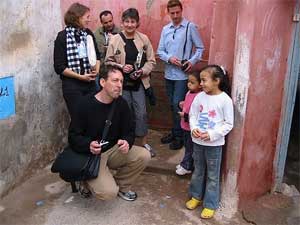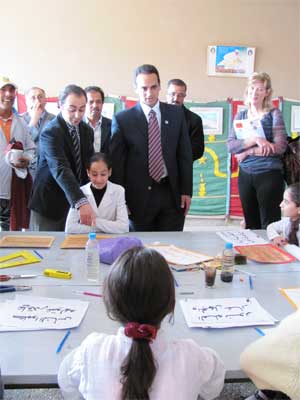Shortly after landing in
Boston after the trip, Matsumiya went to Mayor Joseph Curtatone's
office to talk about future ideas, of which he will disclose as ideas
formulate. Curtatone attended the trip for an official signing of the
partnership with Tiznit City Council President Abdellatif Ouammou.
The week-long agenda was packed with luncheons, presentations, visits to classrooms, art studios, and group discussions.
Lim
was struck by the high level of quality and sophistication in the
artist studios. Their work would have looked right at home in a gallery
in New York City, she said. The Tiznit artists' painting style was akin
to abstract expressionist, which is in contrast to the United States,
where narrative art is making a comeback, Lim said.
Fellow
artist David Columbo, also of Brickbottom, thought it interesting that
the Koran (which the Muslims in Tiznit honor) did not depict people,
which could lend to the abstraction in their art.
A third grade
teacher from Somerville came to Tiznit with her students' art. The work
was hung in the hotel that the group stayed at. A Moroccan mentioned to
Columbo that he was impressed with the huge range of nationalities of
Somerville's students. Columbo agreed and thought it would be a good
idea to have a show in Somerville featuring the art of Tiznit students.
Maurice
learned how little she knew about or understand Islam religion and
Muslim culture. "Without realizing it, I supported the assumption that
we are advanced-superior-because of our technology and that we
superimpose our (Judeo-Christian) standards on both Islam religion and
their culture," she said "It became clear to me this is a misbegotten
and dangerously narrow point of view."
She arrived with some prejudices and left with far more questions and a realization of her ignorance.
"My
personal interaction with Tiznit counterparts and their culture had an
enormous impact on me," she said. "I find myself motivated to better
inform myself, maybe establish meetings, exchanges with the Muslim
community here, particularly Muslim women. I would not imagine thinking
this way before I left."
Cynthia Good, a Methodist minister from
Andover, is also on the board of the Shakespeare Actor's Project, which
is housed by the UME in the Armory building. Word about the trip
trickled across the hallway, and Good decided it would be an
interesting trip to attend. Good prefers to travel in ways where she
can connect with the culture and community, rather than just site see,
so this trip was ideal for her.
She was impressed by the women in Tiznit, who were really dynamic and interesting people.
"During
our last lunch, our task was to think about what may happen next," she
said. "One woman next to me said that she noticed on the Somerville Web
site a certain bike race occurs. She wondered whether we could partner
in bike races somehow. That idea of thinking about further
conversations is how things can grow organically."
Ellin
Reisner, president of the Somerville Transportation Equity Partnership,
went to check out Tiznit's infrastructure and water reclamation
facility, among other things She also went out of cultural fascination.
She was impressed with Tiznit's ingenuity of how the dry country
recycles water for agricultural use, and by the electronic rail system
that does not pollute the air like our country's system. She
appreciated traveling with a civic group that really learned about the
culture.
"It's very interesting to be in a place where you can
learn what life is really like, and not just from a tourist
perspective," she said. "When you get to be with people from another
culture, it is an enriching experience that we all grow from."
Reisner
has always been fascinated by Morocco. "In many ways, Somerville and
Tiznit are very different, but in some ways, we are not," she said.
UME
has a long-standing relationship with Morocco. For the past 12 years,
the UME has sought to empower the most motivated and progressive
secondary school teachers of the Middle East, North Africa, and the
United States through professional development and exchange programs
that equip teachers with the skills and knowledge to broaden their
prospective horizons.
"In general, I was impressed by how
earnest everyone was," Lim said. "I think of Somervillians as having a
streak of irony, of having their tongues firmly planted in their
cheeks. The Moroccans, while quick to smile and laugh, were definitely
not silly."














Reader Comments